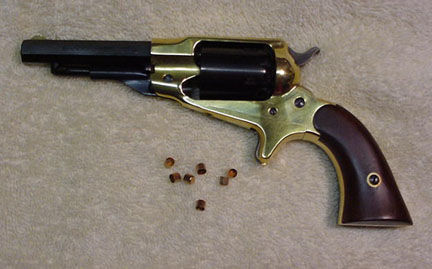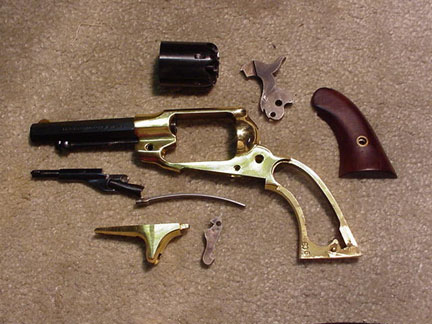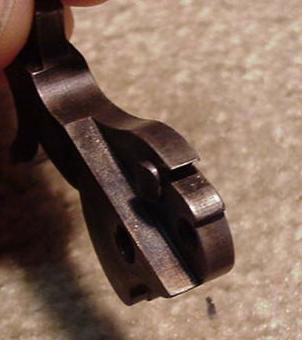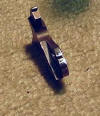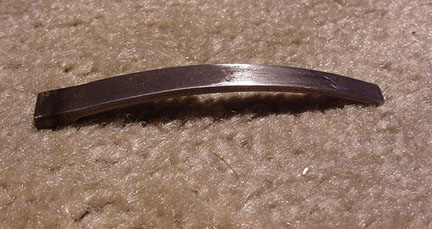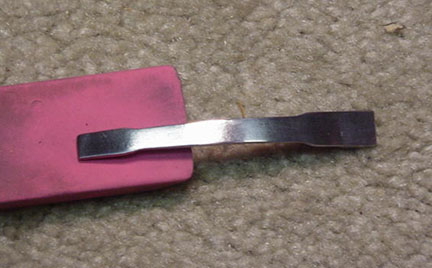Tuning a 5 Shot Remington Pocket Police Revolver
by Mohave Gambler
I finally broke down and bought a cap and ball pocket pistol. The justification was that I would need it for those unusual stage scenarios, but the fact is that I want one because they are really neat. Some advertisements claim the 1863 Pocket Police Revolver was Remington's answer to the Colt 1862. This black powder revolver is made by Pieta in Italy and I was impressed with the little shooter when it arrived, but it did have a few problems that need to be addressed. The timing on the gun was not correct and the cylinder was locking up before the hammer was in the full-cock notch. This usually indicates a problem with the hand being a bit too long. I also noticed that the hammer pull was very stiff and made it difficult to cock the gun. I decided to turn this into a tuning project for the gunsmith project section of my web site.
This project does not include any external modifications so there is very little to display in a picture. The Remington Pocket Police Pistol is a five shot .31 caliber revolver with a 3-1/2" barrel. The barrel & cylinder are blued and the frame is made of polished brass. The Remington uses an integrated brass frame, grip frame, and trigger guard. The trigger & hammer are color case hardened and the gun comes equipped with reasonably attractive walnut grips. The total weight is about fifteen and a half ounces and the gun's overall length is about eight inches. The gun is very concealable and would have made an excellent hideout gun for playing a hand of poker. Remington Pocket Police Project Statement To correct the timing of the revolver and to improve the overall action in a way that the gun becomes much easier to shoot in competition. I would like to see the trigger pull down around five pounds and the hammer should easily come back with a gentle pull of by the thumb. Hammer pressure should be strong enough to consistently fire the caps while also holding the caps in place. Total expenditure is to be kept at zero. The gun will be evaluated for a future conversion to .32 ACP cartridges. The first step in the project is to take the gun apart, take a few measurements, and to evaluate the overall condition of the parts. The parts were in excellent condition and the workmanship was quite good. Unlike the larger Remington New Army revolvers, the hammer spring has no adjustment screw so the only way to remove the spring is to use a drift pin and push it out of the retaining slot. The trigger guard can be easily removed from the frame by removing the small screw that holds it in place. With the trigger guard removed, I removed the trigger and cylinder bolt springs. I then removed the trigger hinge screw and removed the trigger. Wit the main spring out of the frame, I removed the hammer screw and slid the hammer down toward the missing trigger guard. This exposes the hand hinge screw that must be removed in order to remove the hand. With the hand removed, the hammer can be lifted out the top of the frame.
I used a dial caliper to measure the trigger and hammer sear. The hammer sear is about .035 inches while the hammer sear measures about .030 in depth and a rather neutral angle. This is very good since the most desirable sear depth is between .030 and .035. This means the sear will simply have to be polished with an Arkansas Stone in order to remove a little of the roughness. I measured the end play in the cylinder and it came out to be about .010, which is a little tight for blackpowder, but should be acceptable in a pocket pistol.
The metal of the hammer on the pocket pistol was reasonably smooth, but a little polishing would further smooth the feel as the gun is being cocked or fired. I used 320 grit Emory cloth coated with unscented mineral spirits to polish the surfaces and finished the job with an Arkansas stone. I have never developed the skills to get a mirror finish on the metal parts, but they are generally very smooth when I am finished. It is not the object to create a mirror, but to remove the roughness of machining or casting flaws. I usually find some pitting on new hammers and it takes a little polishing to remove the roughness so the parts will move smoothly against each other.
I also polished the sear on the trigger. I am not illustrating the action done on the sear, but anyone can fit the two parts together on their bench and see where the friction can be found. In addition to polishing the sear, I cleaned up casting problems on the cam located on the right side of the hammer, and on each side of the hammer where it rubs against the frame. The purpose of the polishing is to reduce friction in the working parts so that less spring pressure is needed to fire the gun.
Some people are too quick to start reducing spring tension while attempting to lighten the trigger pull on a firearm. Simply reducing the spring tension is not the best approach. The makers of budget firearms do tend to keep their prices affordable by cutting corners on machining and letting questionable parts through their quality inspection process. Additionally, lawyers do not like guns being sold over the counter with a light action that can lead to an accident. Those of us who buy the more affordable guns can smooth and lighten the action in order to upgrade the quality without the input of lawyers. After cleaning up the friction in the action of the little revolver, I started working on reducing the tension on the mainspring in order to lighten the action and provide a better hammer pull. Cap and Ball revolvers need to have a fair amount of mainspring tension in order to keep the hammer seated on the cap. The larger Pietta Remington revolvers allow the user to adjust the spring tension with a screw in the grip frame. The pocket police revolver does not have such a screw so spring tension will have to be reduced by thinning the mainspring. I coated the spring with machinists dye and then scribed a line along the edge of the spring in order to have a guide for grinding. I used a bench grinder to remove metal from the spring and I was careful to always hold the spring in my bare hands to prevent the metal removal from getting the spring too hot and removing tension. Leaf type mainsprings are interesting creatures from a design standpoint. They have earned a reputation for not being reliable and most of that reputation comes from the fact that springs are brittle and people attempt to exceed their design capabilities. When a spring fails, it is usually from a buildup of stress on a flaw in the spring. Any roughness or sharp edge can allow stress to build up and promote a fracture. In order to significantly reduce the potential for a spring failure, we will remove all flaws and smooth and polish the spring so that stress is spread across the entire spring and does not build up on in the flaws.
This was enough to bring the hammer down to a more comfortable amount of pull. I also used crocus cloth to remove the surface flaws while smoothing the edges that had been ground away. The spring can be cut back using a power grinder as long as you hand hold the spring to prevent it from getting too hot. Assembling the little revolver was easy. I slid the hammer back down into place and then down below the trigger assembly so the hand could be slid in next to the hammer and the hand pivot screw could be reinstalled. I use gun grease to lubricate the sear and cylinder lock cam. I had to use a rawhide mallet to drift the mainspring into place, but it worked well. I then slid the cylinder locking bolt and and trigger assembly back into place and replaced the trigger screw. After installing and checking the action parts, I reinstalled the split trigger and cylinder bolt spring, the trigger guard, and the rammer assembly. That completed the basic installation of the gun. A little grease was put on the cylinder pin and the cylinder was slid into place.
This little revolver will be used whenever a pocket pistol is required for my Cowboy Action Shooting. Although this gun seemed very crude and stiff when it first came out of the box, the reworked action is light and smooth. It took only a few hours to complete this conversion and turn an economical cap and ball revolver into a fine gun for Cowboy Action Shooting.




